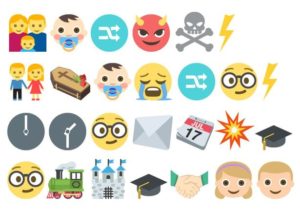This is an exercise for writers who feel completely paralysed by the prospect of a blank page. Blank pages can be scary for any writer. They’re so pristine, so empty! And you’re thinking What if I spoil this lovely clean page with my silly rubbish? What if I can’t think of anything to write at all?
You might also have lots of great ideas but the idea of putting them into words is scary. What if I spell everything wrong? What if I can’t think of the right words?

But you can make your brain feel safer by breaking the task down into very small chunks and this is one way to do that. It’s a bit like the Snowflake Method but it has emojis and is therefore way more fun:
1. Without writing anything down at all, think of a story in your head. (Or tell it aloud to the group or a partner.) It can be extremely rough and vague, it’s just the bare bones of a story. A character, a beginning, middle and end is plenty. E.g. the whole of Harry Potter might be summarized as: ‘An orphan is told he’s a wizard and gets sent to wizard school, where he encounters the evil villain who killed his parents, fights him and avenges their deaths.’ Done!
2. ‘Write’ the story down in the form of emojis. There are hundreds of emojis online you can search for and even if there isn’t one for the specific thing you want, you can just choose one that’s close. Again, it’s just an outline, ten emojis would be fine, or however many you want to use. The beginning of Harry Potter might look like this:

3. Take each emoji and turn it into one sentence. So now instead of ten emojis, you’ve got ten sentences. Maybe 100-200 words. It’s still just a skeleton plan of a story but you’re probably already thinking of lots more detail you’d like to add to flesh it out. So the first 6 emojis of the Harry Potter example might become:
Once there was a happy family called the Potters. The baby in the family was called Harry. The family got mixed up in a war. The war was with an evil wizard called Voldemort. He killed Harry’s Mum. In the attack, Harry was left with a scar. Etc.
4. Now turn each sentence into a whole paragraph by adding the details. You could include physical descriptions of people and places, dialogue, actions, what people are thinking etc. So now instead of ten sentences you’ve got ten paragraphs. And instead of a hundred words you’ve got maybe 500 or 1000! So the first sentence in the Harry Potter example could become: James and Lily Potter lived in a small house on a quiet street in Surrey and none of their neighbours knew they were actually wizards. James was tall with dark hair while Lily had red hair and green eyes and when they’d been married for 2 years they decided to have a baby… etc. (Hey, I never claimed to be JK)
5. If you feel your story is finished, great, well done! If you feel there’s more you’d like to add, or bits you’d like to change or polish, go back and do that. Keep expanding each section until you feel the story has been told.

Obviously, it’s easier to do this on a computer or phone where you can edit more easily. I think it’s great because it never actually feels like you’re ‘writing’ (which is the scary part because you feel like you can get it wrong or write something rubbish). It feels like you’re just planning the plot right up until the last moment, when you realise you’ve actually written a whole story! And going back and changing things over and over is a good way to learn how important editing is and how you really don’t have to produce something perfect first go on that blank page.
